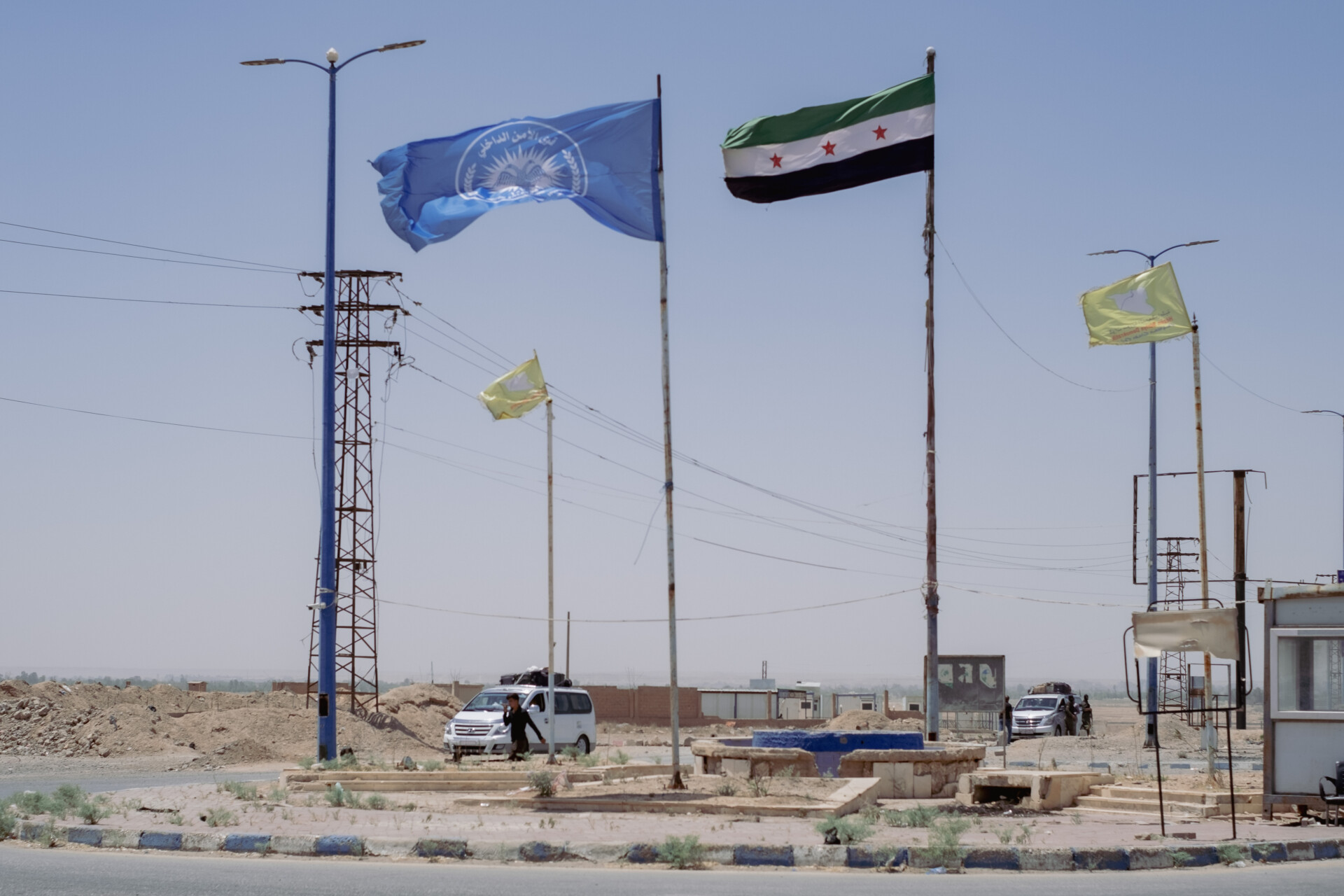Beneath a scorching sun, the river emerged in the distance like an open wound. The Euphrates, which nourishes one of Syria’s most fertile valleys, has become a dividing line between two territories that barely brush against each other. To the water’s north and east lies the area controlled by an Arab-Kurdish coalition, known as the Autonomous Administration of North and East Syria (AANES), which administers roughly one-third of the country. To the south and west are the territories now governed by the new authorities in Damascus, led by transitional President Ahmad al-Sharaa.
With Kalashnikovs slung over their shoulders, Kurdish and Arab fighters of the self-styled Syrian Democratic Forces (SDF) militia sped along the battered roads that follow the northern bank of the river. Their convoy halted at the foot of a crumbling concrete bridge — one of the few that still connects these two separate worlds.
There stood Mahmoud Jalil, a member of the Arab-Kurdish security forces. With methodical precision, he inspected the vehicles leaving the autonomous zone en route to downtown Deir ez-Zor, across the water in government-held territory. On the other side, the checkpoint manned by al-Sharaa’s forces was clearly visible. “Every morning, we wave from a distance,” he said with a smile. “But nothing more. We don’t know each other.” A fracture line, inherited from Syria’s tragic civil war — and still unhealed, even seven months after the fall of the bloodstained regime of former President Bashar al-Assad.
“There is no cooperation with the security forces stationed just 200 meters [220 yards] away. We do have a line of communication, but it’s limited to vehicle movement — exactly as it was under the previous regime,” said Gen. Abou Ali Fulaz, a native of Deir ez-Zor.
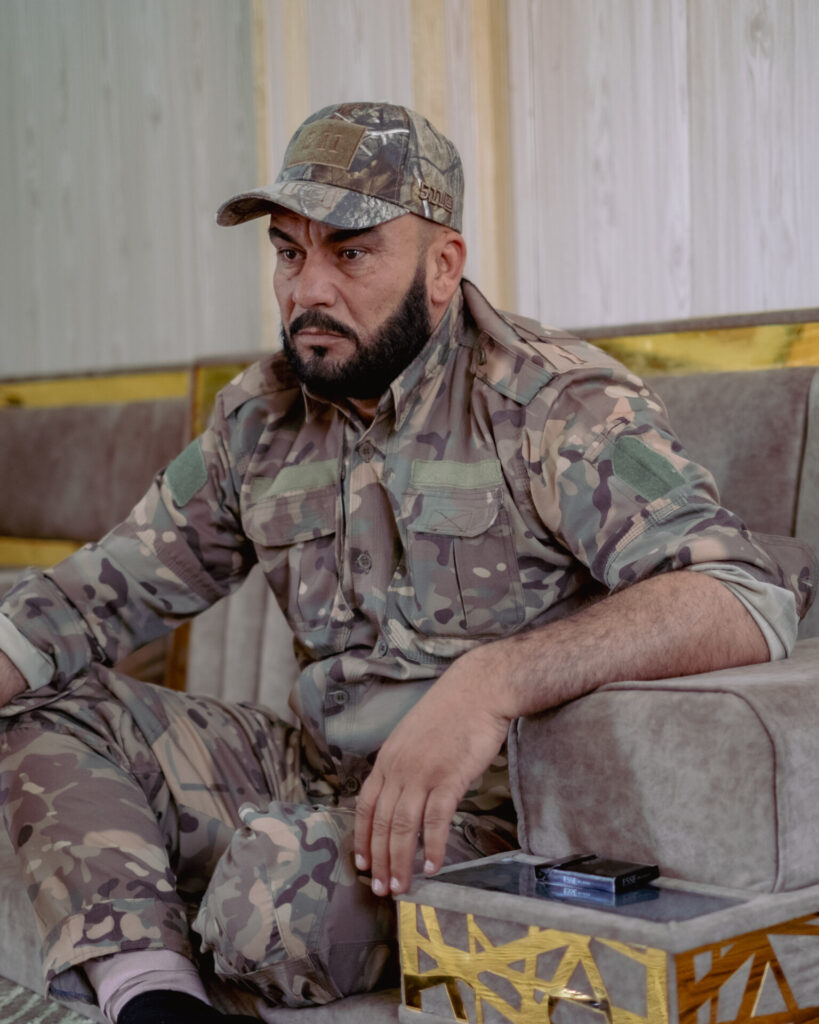
In the aftermath of the country’s liberation from Assad, this status quo seemed to suit all sides. The AANES, which had taken advantage of the Syrian war to lay the foundations of a proto-state, retained control of the northeastern third of the country. Meanwhile, al-Sharaa’s forces, overwhelmed by the scale of the task of governing the areas they now controlled, likely welcomed the implicit postponement of any immediate reintegration.
This, at least, is what several senior officials within the AANES assert. Siyamend Ali, a spokesperson for the People’s Protection Units (YPG) militia, which is part of the SDF, said: “Let’s be clear, the new government is already dealing with a massive challenge. It does not have the manpower to deploy and take charge of the autonomous region. It was pushed into negotiations.”
Still, the situation seems bound to evolve, as Syrian “reunification” is widely supported by both the country’s population and the international community. In this context, and after months of uncertainty — punctuated by clashes between the SDF and pro-Turkish groups over control of the strategic Tishrin Dam on the Euphrates, east of Aleppo — AANES officials finally, almost unexpectedly, found their path to Damascus.
On March 10, 2025, an agreement was signed between al-Sharaa and Mazloum Abdi, the general commander of the SDF. Hailed as a major step forward, the deal laid the groundwork for the integration of the SDF into the state’s military and administrative structures, while sketching out a tentative normalization between the two entities.
Since then, however, little or nothing has changed. A YPG source, who requested anonymity to speak freely, explained: “The agreement signed in March came in the wake of the massacres of Alawites committed by pro-government militias. Beyond public declarations, it satisfied all sides. But it remains purely theoretical to this day. For now, we are still trying to find a real starting point for this cooperation.”
Could the growing threat of a resurgent Islamic State group, still deeply rooted in southeastern Syria, become the unlikely common ground between the two camps? According to several key security sources, it might. Western diplomats appear to be structuring their efforts around this very question, attempting to build a framework for coordination between the new government and the autonomous region.
In this light, a plan for joint patrols aimed at dismantling Islamic State cells — still active along the Euphrates and throughout the Badiya desert — has been quietly discussed behind closed doors, according to security sources. “It’s a good idea in theory, but we’re still very far from it,” Fulaz said. “No cooperation has been established, not even for basic things like sharing intelligence on potential sleeper cells.”
It’s a paradoxical situation: As both sides eye each other in strategic silence, the Islamic State continues to expand its operations. And its targets are no longer limited to the Arab-Kurdish forces who regularly endure ambushes along the northern banks of the Euphrates. On May 19, a jihadist attack — reportedly carried out by Islamic State cells — hit a government police outpost in al-Mayadin, on the southern side of the river. Three people were killed and several others wounded.
Gen. Firas, 43, oversees the SDF’s security operations in the region. With his unit, he conducts regular patrols through a string of villages nestled tightly along the river. The mood is heavy. Despite the SDF’s integration of many Arab fighters from the region, they are still widely viewed as representatives of a foreign, Kurdish-dominated authority. Faced with a diffuse and persistent threat, the intensity of the SDF operations in these areas often worsens local perceptions rather than building trust.
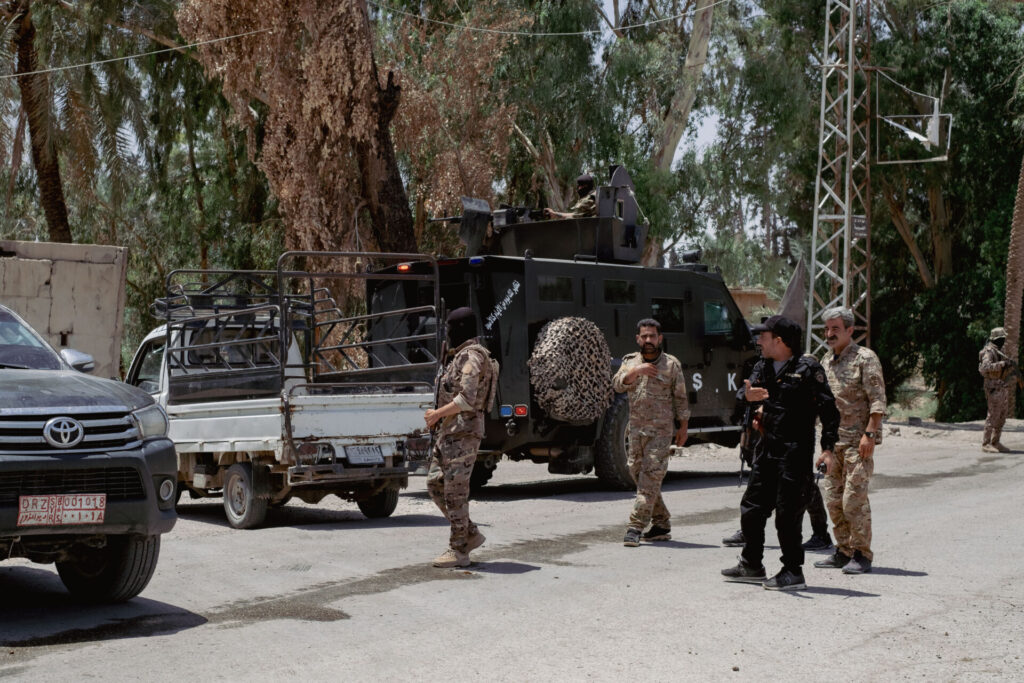
In these rural areas, it is often the eyes more than the words that speak: men standing expressionless as the patrols pass by, children turning away from the soldiers’ smiles. “In this area, many villagers support [the Islamic State], either out of sympathy or fear, of them or of us, I don’t know,” said a young SDF fighter from Raqqa. Without hesitation, he acknowledged the hostility many locals feel toward the SDF.
Still, Firas attempted to provide some measure of reassurance. “Anything can happen here. But we have informants everywhere, and that lets us act early, often before attacks are carried out by sleeper cells. We have no choice, we must comb the area constantly. Still, even with sources on the other side of the river, we’ve been increasingly vulnerable to attacks coming from the southern bank.” The river has become a gaping security fault line, exploited by the Islamic State while the government and the AANES remain frozen in place.
Still, several encouraging signs have emerged. In April, the YPG’s withdrawal from Kurdish neighborhoods in Aleppo, followed by recent prisoner exchanges between the AANES and the government, pointed to tentative yet symbolically significant gestures. These initiatives have served as a kind of testing ground for mutual trust between the two sides.
In May, a delegation from the new government visited al-Hawl camp, where some 32,000 individuals remain detained, most of them captured after the fall of the Islamic State’s so-called caliphate. While Baghdad has, for months, conducted weekly repatriations of Iraqi women, the fate of the many Syrian nationals in the camp has now been taken up directly by the new government.
“Contrary to what was reported, it was never a question of transferring control of al-Hawl to the new government,” said Gen. Cani Ahmed, who oversees the area surrounding the camp. “The aim was to repatriate Syrian women and children to their towns of origin. As far as we’re concerned, we had already carried out this work during the summer and fall, for those whose hometowns lie within the autonomous region. That process took place under the supervision of local tribal leaders.”
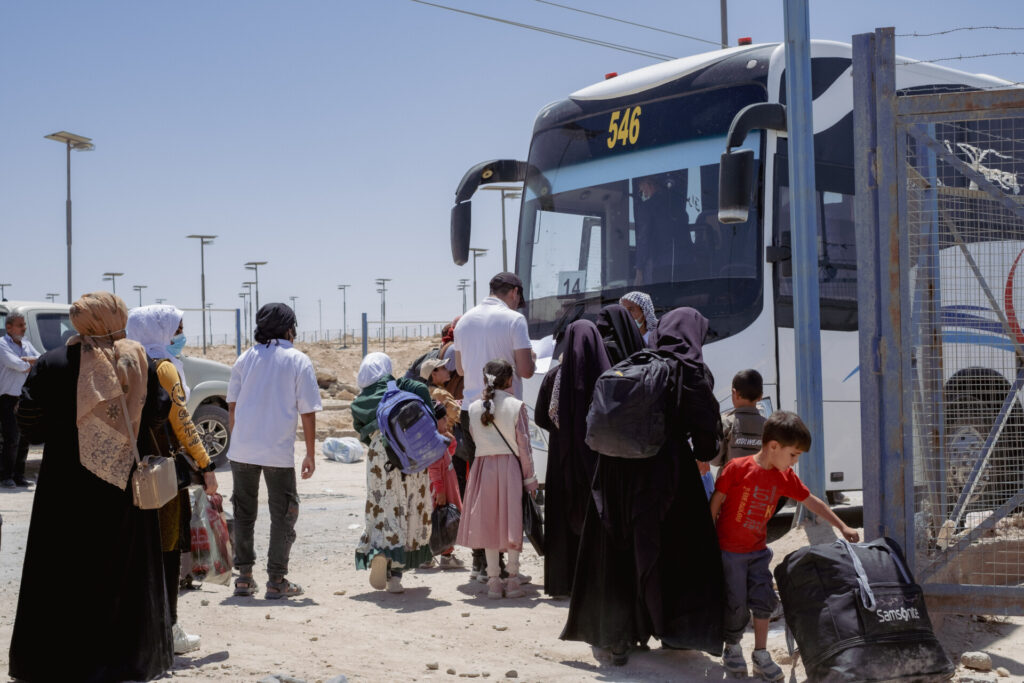
Cihan Hanan, who oversees the civilian administration of the camp and was the only woman present at the meeting, recounts: “This meeting brought together around 10 stakeholders — the Ministry of Defense, intelligence services, the Americans. … We could not bear the responsibility for their return alone. It was up to Damascus to do so, to determine what they could offer these people in the future. There was real hesitation on the part of some participants, but the Iraqi example — which has worked quite well and has not generated security problems following repatriations — reassured them. We received assurances of the government’s willingness to offer them better prospects. So, of course, we raised no objection.” She describes the dialogue as constructive but far from straightforward, given the unresolved tensions that remain.
“I never thought I would find myself sitting at the same table as some of these people,” she says. “I’m from Afrin, and I had to leave my town and lose everything I had because of the Turkish-backed militias. But my responsibilities left me no choice. We have to move forward.”
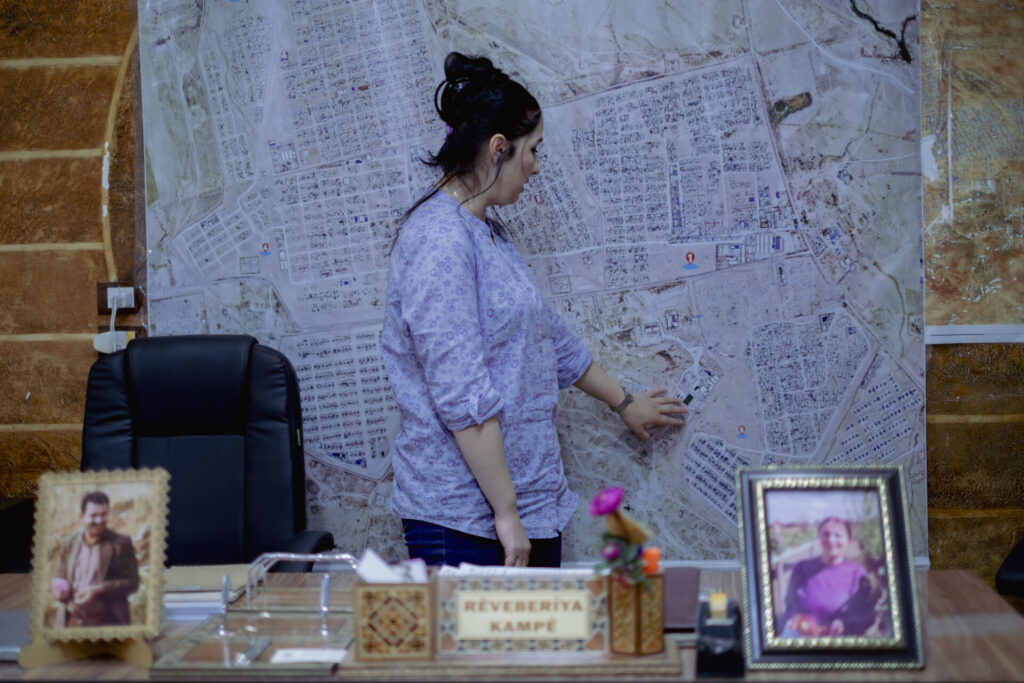
In northeastern Syria, signs of deep mistrust toward the new authorities in Damascus are hard to overlook among Arab-Kurdish forces. This unease appears to stem from multiple factors, including the erosion of territorial gains secured during the war and persistent doubts regarding armed factions that the SDF were still fighting not long ago. Yet at the civilian level, divisions are striking. While the overwhelming majority of Arabs living in the autonomous region express support for immediate integration into the new Syrian state, the Kurdish population tends to remain more cautious.
“I’m not opposed to the idea,” said Jihan, a 23-year-old Kurdish resident of Qamishli. “But first we need to be sure that Syria isn’t going to fall apart again. The autonomous administration protects us. We can’t just dismantle everything and find ourselves in danger again if things go wrong. We’ve already shed too much blood for this stability.”
“We have chosen, out of a sense of responsibility, the path of dialogue. But we are well aware that some actors in the new government have criminal pasts. Entrusting them with responsibilities is a serious mistake,” said Ali, the YPG spokesperson.
The recent appointment of Abu Hatem Shaqra to head the 86th Division, operating between Raqqa and Deir ez-Zor, has stirred particular shock. A former commander of the Ahrar al-Sharqiya group, Shaqra is accused of multiple war crimes. In 2019, he personally oversaw the brutal execution of the Kurdish political figure Hevrin Khalaf, whose vehicle was intercepted on a northeastern Syrian road. Footage of her mutilated body, filmed by his own men, spread worldwide.
“[It was] a disastrous signal that caused a major loss of confidence in our ranks,” said Fulaz of the SDF. From his base, Firas remained cautious: “I am open to the idea of working together. But I stay guarded. Many of their men come from radical factions we fought in Manbij and elsewhere. How can we trust them? This will take time.”
According to senior U.S. officials cited by local and international media, Washington has informally set a deadline for the end of August to finalize the integration of the SDF into government forces.
“[President Donald] Trump wants things to move fast. He’s entered a phase of military disengagement and is growing impatient. He wants progress on all fronts — Syrian reunification, counterterrorism assurances and normalization with Israel,” said a diplomatic source.
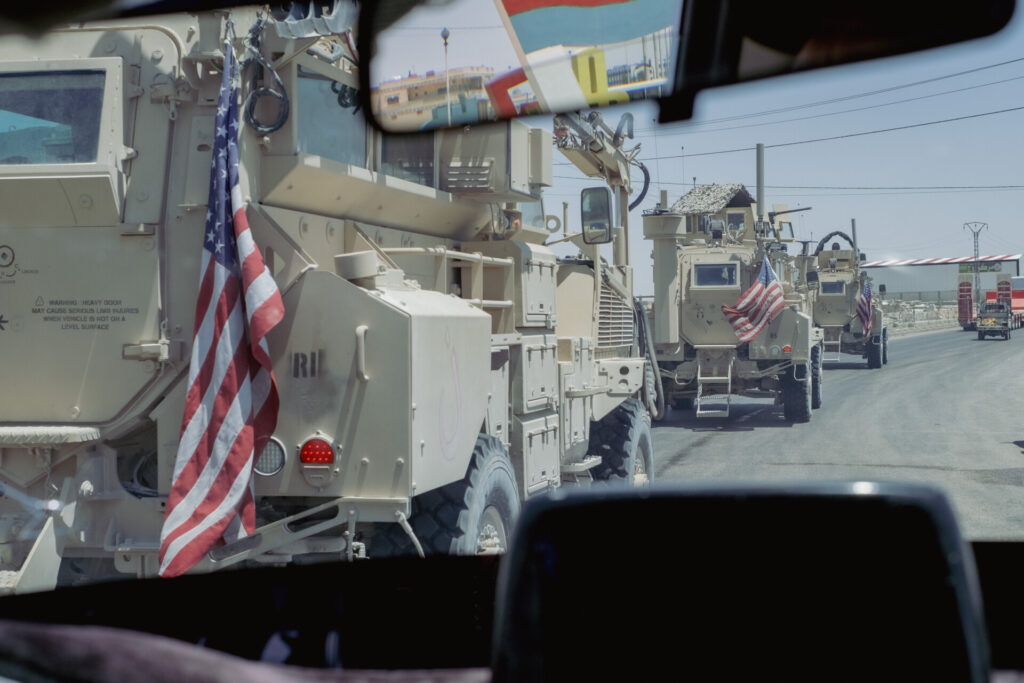
The American tone has grown sharper in recent days as it relates to Kurdish demands for autonomy, with U.S. Ambassador Tom Barrack urging the Kurds to integrate within the Syrian state following a visit by Mazloum Abdi to Damascus. “We don’t owe them the ability to have their own independent government within a government,” he said during a July briefing in New York.
“There’s not an indication that there’s going to be a free Kurdistan, a separate SDF state,” he added. “There’s no indication on our part that there’s going to be a separate Alawite state, or a separate Druze state. There’s Syria.”
Syrian officials appear to be hinting that the Kurds are stalling — a recent statement following a meeting between Sharaa and Kurdish officials repeated its rejection of federalism in Syria and urged Kurdish forces to join the ranks of government troops. The messaging points to an increasingly assertive Sharaa, emboldened by American support and a shift in Israeli rhetoric toward him, from attacks emphasizing his jihadist roots to recent reports indicating that Israeli Prime Minister Benjamin Netanyahu is seeking American mediation for peace talks.
Away from the media spotlight and both local and international press, a cycle of discussions is currently underway between Damascus and the AANES. At stake are two burning issues: the terms of SDF integration and the future of the autonomous region. While the SDF, seeking institutional continuity, is demanding collective integration of its forces as a single unit, Damascus is insisting on individual integration of soldiers into the Syrian army. This remains another point of disagreement, along with the fate of the administrative structures of the AANES.
Cédric Labrousse, a doctoral candidate at the School of Advanced Studies in the Social Sciences in Paris, who works on armed groups and political movements in Syria, said: “Some observers believe there are now two camps: the leadership of the AANES, more inclined to a standoff with Damascus, and those around the leadership of the SDF, oriented toward dialogue with the new authorities. For now, it is this second camp, notably represented by Mazloum Abdi, that seems to be prevailing.”
So is the entirety of northeastern Syria destined to return to Damascus’ control, as some predict? While this appears to be the case for Arab-majority areas recaptured during the war against the Islamic State, the situation is more delicate when it comes to Kurdish-populated zones along the Turkish border. “Ultimately, there is a viable option for both Damascus and the AANES, which lies in local autonomy at the municipal level. The precedent here is the unique, though significant, agreement that allows Kurds to govern their neighborhoods autonomously in Aleppo, with their own schools, administration and police force,” Labrousse said. “That model could easily be replicated elsewhere. For Damascus, it would also be a net gain, since these areas might prove very difficult to govern if reintegrated by force into the new state.”
Then there is the particularly thorny issue of the SDF, a force numbering several tens of thousands of fighters, most of them Arabs. “Their integration could follow two paths,” Labrousse said. “The first involves maintaining local police forces, as seen in the Kurdish neighborhoods of Aleppo, provided that they report to the Interior Ministry in Damascus. This model already exists in Sweida, in southern Syria, with some Druze groups. The second option is the creation of one or two Syrian army divisions in the Hasaka or Kobane region. Nominally and within the organizational chart, they would be part of the Syrian army, but they would be able to recruit troops locally.”
This is a plausible scenario, since the new government has already proposed something similar in Sweida, suggesting the creation of a locally based army division composed of former Druze militia members.
For the time being, nearly all figures interviewed for this article remained tight-lipped about the content of these negotiations. Only a few high-ranking SDF sources hinted that the talks with Damascus were at a very advanced stage, and that a “surprise agreement” could be announced soon, much like the March deal. These high-level negotiations, deliberately kept away from the media, are reportedly being pushed by the U.S. as well as Turkey.
Inside a barracks of the Kurdish Women’s Protection Units (YPJ), the female branch of the YPG, the uncertainty is palpable. Integrated within the SDF, their future role in the state apparatus is particularly complex. The fate of these several thousand women is anything but trivial. On the one hand, the SDF firmly rejects their demilitarization; on the other, if al-Sharaa were to accommodate their integration, he could risk alienating the more radical factions among his forces.
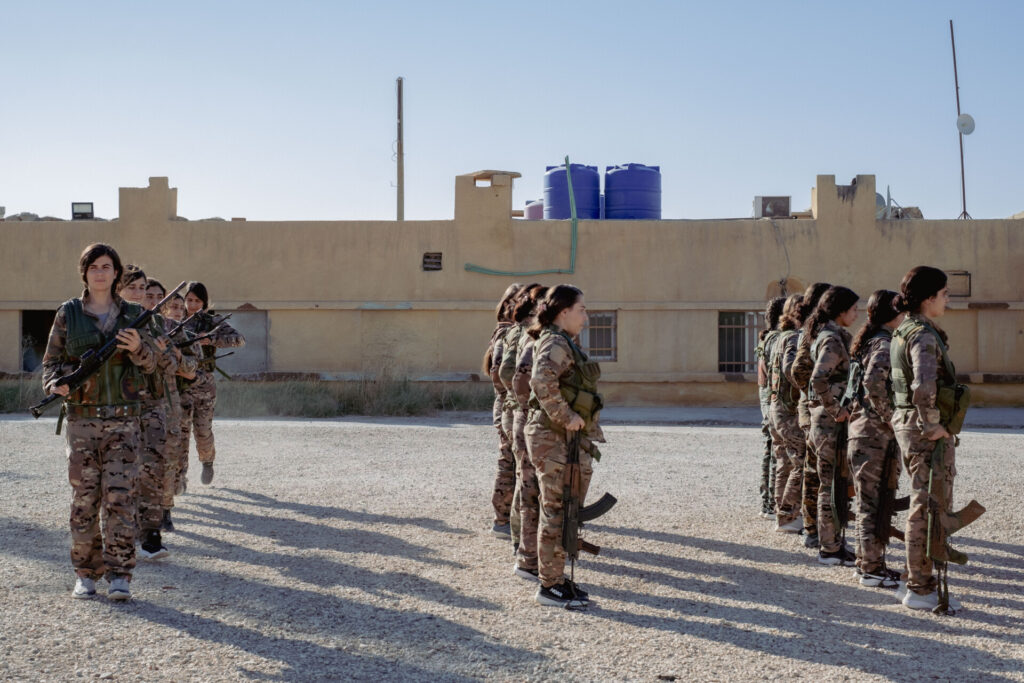
To make things even more complicated, Turkey, which sees Syria’s Kurdish militias as tied to the Kurdistan Workers’ Party (PKK), a militant group that fought for decades against the Turkish state, demands their disarmament. “Turkey holds leverage over Damascus, but it will not go any further,” commented a former Turkish diplomat. “[President Recep Tayyip] Erdoğan is securing an unexpected peace with the PKK. He will not risk jeopardizing it for the sake of the YPG and YPJ.”
Vian Adar, a YPJ commander, remained steadfast. “We will do everything we can to move the conversation forward, to shift the lines and to make ourselves accepted, even if it’s difficult. We are Syrian women before we are YPJ, and we must continue fighting to protect women, all women.”
While many still see the AANES as a separatist project, Amargui, a 25-year-old fighter, pushed back. “Rojava [the Kurdish name for the territory] does not mean division. These 12 years of struggle were never about breaking away from the rest of the country, but about protection. For me, it’s those who took power in Damascus who are widening the gap. Women and minorities, such as Alawites, Druze, Kurds or Christians, do not feel safe under the new government. As long as that is the case, we will need to protect ourselves.”
She continued: “As for our integration into the unified armed forces, we are ready to fight on the ideological front. To force those who don’t want us to accept us.”
That is the heart of the matter: to find shared ground in a reborn Syria, rather than new dividing lines, and to break a vicious cycle of violence that has endured for half a century.
“Spotlight” is a newsletter about underreported cultural trends and news from around the world, emailed to subscribers twice a week. Sign up here.



